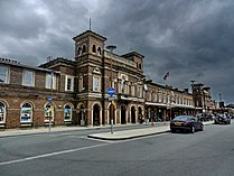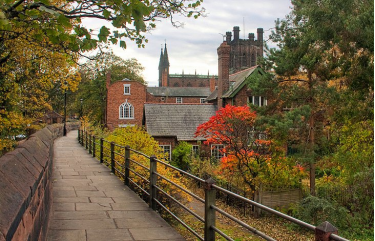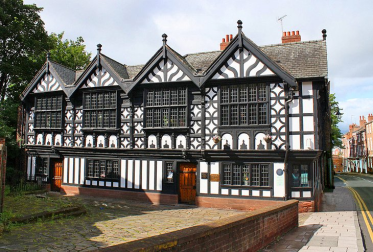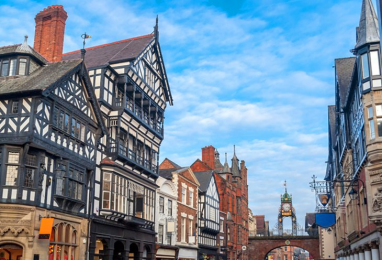Chester, Cheshire, England, UK 作者: 来源: 发布时间:2021-01-05
I. Population and Area
Continent: Europe
Country: The U.K
State/Province: England
City/Town: Carlisle, Cumbria
Total Area: 188.41 (sq mi)
Population in 2018: 33.91(thousand)
II. Natural Geography (environment and resources)

Chester lies at the southern end of a 2-mile (3.2 km) Triassic sandstone ridge that rises to a height of 42 m within a natural S-bend in the River Dee (before the course was altered in the 18th century). The bedrock, which is also known as the Chester Pebble Beds, is noticeable because of the many small stones trapped within its strata. Retreating glacial sheet ice also deposited quantities of sand and marl across the area where boulder clay was absent.
The eastern and northern part of Chester consisted of heathland and forest. The western side towards the Dee Estuary was marsh and wetland habitats.
Roads
The city is a hub for major roads, including the M53 motorway towards the Wirral Peninsula and Liverpool and the M56 motorway towards Manchester. The A55 road runs along the North Wales coast to Holyhead and the A483 links the city to nearby Wrexham and Swansea in Wales.
Bus transport in the city is provided by Stagecoach Merseyside & South Lancashire and Arriva Buses Wales, the council owned and operated ChesterBus (formerly Chester City Transport) having been sold to First Chester & The Wirral in mid-2007. A new bus exchange is being built in the city at Gorse Stacks is scheduled for completion in early 2017. In October 2016, a new regular EasyBus service began from Chester to Manchester Airport.
Railways
Chester formerly had two railway stations. Chester General remains in use but Chester Northgate closed in 1969 as a result of the Beeching cuts. Chester Northgate, which was located North East of the city centre, opened in 1875 as a terminus for the Cheshire Lines Committee. Trains travelled via Northwich to Manchester Central. Later services also went to Seacombe (Wallasey) and Wrexham Central via Shotton. It was demolished in the 1970s and the site is now part of the Northgate Arena leisure centre.
In late 1847 the Dee bridge disaster occurred when a bridge span collapsed as a train passed over the River Dee by the Roodee. Five people were killed in the accident. The bridge had been designed and built by famed-railway engineer Robert Stephenson for the Chester and Holyhead Railway. A Royal Commission inquiry found that the trusses were made of cast iron beams that had inadequate strength for their purpose. A national scandal ensued and many new bridges of similar design were either taken down or heavily altered.
Cycling
There are a series of colour-coded signposted cycling routes around the city.
On 19 June 2008, then Secretary of State for Transport Ruth Kelly named Chester as a cycling demonstration town. This initiative allowed for substantial financial support to improve cycling facilities, and a number of schemes were planned.
Potential schemes included a new pedestrian and cycling bridge across the River Dee, linking the Meadows with Huntington and Great Boughton, an access route between Curzon Park and the Roodee, an extension to the existing greenway route from Hoole to Guilden Sutton and Mickle Trafford, and an access route between the Millennium cycle route and Deva Link. However following a reorganisation of the local authorities effective 1 April 2009 the Conservative-led administration of the newly established Cheshire West and Chester council was not very supportive, so comparatively little was actually achieved.
Canals
Canal cutting by Chester city walls
The Chester Canal had locks down to the River Dee. Canal boats could enter the river at high tide to load goods directly onto seagoing vessels. The port facilities at Crane Wharf, by Chester racecourse, made an important contribution to the commercial development of the north-west region.
Map showing the proposed extensions of the Ellesmere Canal to Chester and Shrewsbury
The original Chester Canal was constructed to run from the River Dee near Sealand Road, to Nantwich in south Cheshire, and opened in 1774. In 1805, the Wirral section of the Ellesmere Canal was opened, which ran from Netherpool (now known as Ellesmere Port) to meet the Chester Canal at Chester canal basin. Later, those two canal branches became part of the Shropshire Union Canal network. This canal, which runs beneath the northern section of the city walls of Chester, is navigable and remains in use today.
III. GDP
In 2018, 45M (£)
IV. Industrial Characterisitics
Major industries: Chester's main industries are now the service industries comprising tourism, retail, public administration and financial services. Many domestic and international tourists visit to view the city's landmarks and heritage with a complementary benefit to hotels and restaurants.
Big project:Community Warehouse Project
Details: The Community Warehouse Project of Chester County is a service organization that collects and redistributes donated furniture and other household items to individuals and families in need within the region. It is generally a one-time, free service to pre-screened recipients, supported through the generosity of those within our community.
If you would like to donate furniture or make a financial contribution to the Community Warehouse Project, please visit our donation page.
V. Attractions
1. City Walls:

Built mostly of red sandstone, Chester's City Walls follow the even older Roman walls, except where they extend to the river to include the Castle. The complete circuit - the best preserved of its kind in Britain - is a nearly two-mile walk taking in the four main gates: Northgate, Eastgate, Bridgegate, and Watergate. At Eastgate, you'll see a clock erected in 1897 to mark Queen Victoria's Diamond Jubilee, while at Northgate, traces of Roman foundations can still be seen. Another must-see while walking the walls is King Charles' Tower. It was here in 1645 that Charles I witnessed the defeat of his troops at Rowton Moor during the English Civil War (the tower houses a small civil war museum, and evidence of the conflict can still be seen at places along the wall).
2. Chester Rows:

Among Chester's most distinctive features are its galleried walkways, with their many shops running the length of the old stone and half-timbered buildings. Dating from the 14th century, the Chester Rows evolved from houses and shops built partly in front of (and partly on top of) piles of rubble left from the Roman ruins. These rows are found in all four of the town's main streets which, following the Roman town plan, meet at right angles at the market cross. In Eastgate, Bridge, and Watergate Streets, the galleries are at first floor level, while in Northgate Street they're mostly at ground level.
3. Watergate and Lower Bridge Streets:

Watergate Street has several exceptional half-timbered houses, including God's Providence House, built in 1652 and so named as its inhabitants were spared the plague, and Bishop Lloyd's House, with its beautiful carvings. Leche House (1579) also has elaborate half-timbering, as does richly-decorated Stanley Palace (1591).
VI. History
The Roman Legio II Adiutrix during the reign of the Emperor Vespasian founded Chester in AD 79, as a "castrum" or Roman fort with the name Deva Victrix. It was established in the land of the Celtic Cornovii, according to ancient cartographer Ptolemy, as a fortress during the Roman expansion northward, and was named Deva either after the goddess of the Dee, or directly from the British name for the river. The 'victrix' part of the name was taken from the title of the Legio XX Valeria Victrix which was based at Deva. Central Chester's four main roads, Eastgate, Northgate, Watergate and Bridgegate, follow routes laid out at this time.
A civilian settlement grew around the military base, probably originating from trade with the fortress. The fortress was 20% larger than other fortresses in the Roman province of Britannia built around the same time at York (Eboracum) and Caerleon (Isca Augusta); this has led to the suggestion that the fortress, rather than London (Londinium), was intended to become the capital of the Roman province of Britannia Superior. The civilian amphitheatre, which was built in the 1st century, could seat between 8,000 and 10,000 people.It is the largest known military amphitheatre in Britain, and is also a Scheduled Monument. The Minerva Shrine in the Roman quarry is the only rock cut Roman shrine still in situ in Britain.
The fortress was garrisoned by the legion until at least the late 4th century. Although the army had abandoned the fortress by 410 when the Romans retreated from Britannia, the Romano-British civilian settlement continued (probably with some Roman veterans staying behind with their wives and children) and its occupants probably continued to use the fortress and its defences as protection from raiders from the Irish
VII. Culture
The major museum in Chester is the Grosvenor Museum which includes a collection of Roman tombstones and an art gallery. Associated with the museum is 20 Castle Street in which rooms are furnished in different historical styles. The Dewa Roman Experience has hands-on exhibits and a reconstructed Roman street. One of the blocks in the forecourt of Chester Castle houses the Cheshire Military Museum.
The £37m Storyhouse arts centre opened in the city centre in 2017, and includes a theatre, cinema, restaurant and the city's main library. It is housed in the city's remodelled 1936 Odeon Cinema, and replaces the Gateway Theatre and the former library on Northgate Street.
Chester Little Theatre is based in Newtown and run by Chester Theatre Club. It generally stages 5 or 6 plays each year. Chester Music Theatre is based in a converted church in Boughton. There was a multiplex cinema and a ten pin bowling alley at Greyhound Retail Park on the edge of the city but these have closed and the cinema has moved to Broughton, just over the border in North Wales. A new Picturehouse multi-screen cinema is being built in the city centre as part of the Northgate Project, due for completion in 2022. Chester has its own film society, a number of amateur dramatic societies and theatre schools.
The Groves area of Chester is the location of a Grade II listed bandstand, built in 1913. A programme of afternoon performances runs every weekend and Bank Holiday from May to August each year, which usually includes brass bands, choirs, jazz, blues and acoustic performers. The current Bandstand Coordinator is Luke Moore, who was appointed in 2018 and has expanded the programme to include a mixture of visual art, theatre, poetry and community events, alongside a variety of musical performances.
Grosvenor Park Open Air Theatre, founded in 2010, is the only site-specific professional open-air theatre company outside London. It has an eight-week annual summer repertory season.
To the east side of the city is Chester Zoo, the UK's largest zoo with over 11,000 animals in 110 acres of award-winning gardens.
Numerous pubs, nightclubs and bars, some of which are based in medieval buildings, populate the city.
VIII. Other information
Chester had a tram service during the late 19th and early 20th centuries which ran from Saltney, on the Welsh border in the west, to Chester General station, and thence also to Tarvin Road and Great Boughton. It featured the narrowest gauge trams (3' 6") in mainland Britain, due to an act of Parliament which deemed that they must be the least obstructive possible.[citation needed]
The tramway was established in 1871 by Chester Tramways Company. It was horse-drawn until it was taken over by the council in 1903. Renamed as Chester Corporation Tramways, it was reconstructed to the 3'6" gauge, and electrified with overhead cables. The tramway was closed in February 1930, a fate experienced by most other systems in the UK. All that remains are small areas of uncovered track inside the former bus depot, and a few tram-wire supports attached to buildings on Eastgate/Foregate Street, although substantial sections of the track remain buried beneath the current road surface.
IX. Contact information
Mayor/Officer: Mark Williams
Tel: +44 (0)1244 511000
Mail:finance.admin@chester.ac.uk
